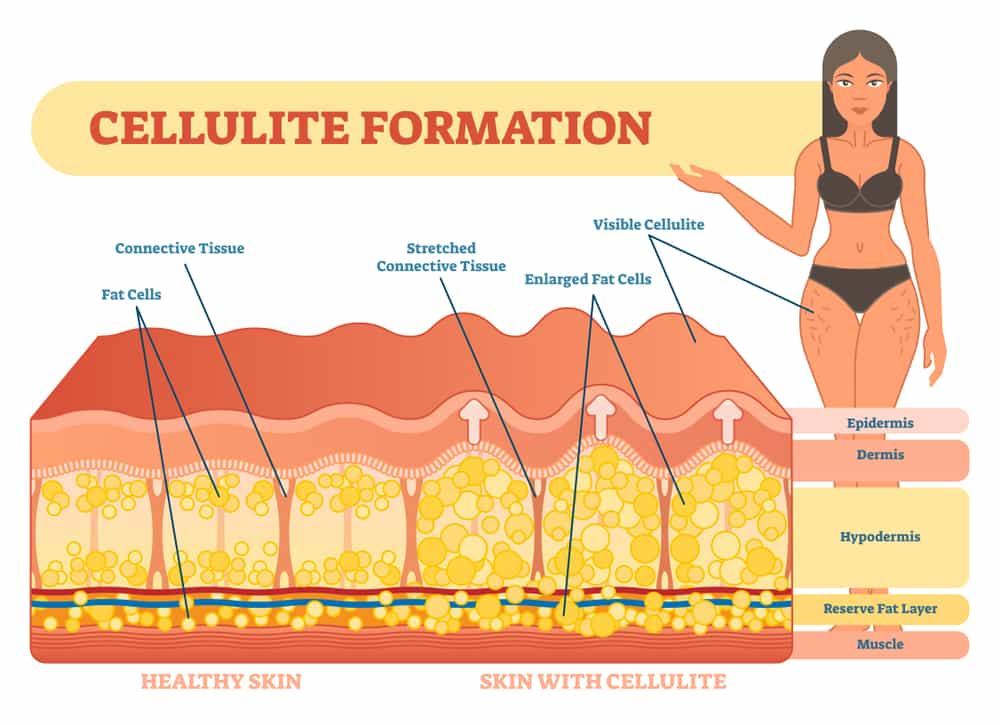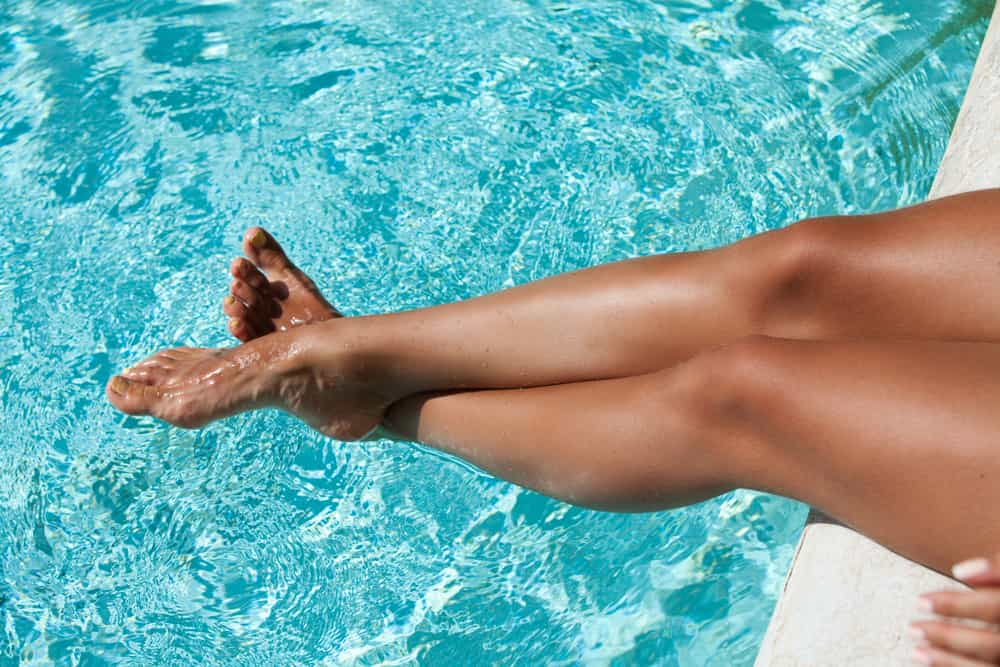When Does Cellulite Start?

What Is Cellulite?
Cellulite begins to emerge between the ages of 25 and 35. Estrogen influences the blood vessels. When estrogen levels begin to fall, receptors in blood vessels and thighs are lost, resulting in reduced circulation. A slew of medicines and techniques claim to target and eliminate the lumpy fat on thighs, bottoms, arms, and bellies, but a miracle cellulite assassin has yet to be discovered. With decreased circulation, less oxygen and nutrition reach that location, resulting in a drop in collagen formation... [At the same time], fat cells begin to expand and protrude through the collagen, resulting in the lumpy fat known as cellulite. Women tend to have cellulite around their knees, saddlebags, and buttocks because they have three layers of fat in these locations rather than just one. Women have different levels of fat in their stomach and triceps.

Causes
Cellulite's causes are not well understood. It consists of fat sandwiched between fibrous connective cords that join the skin to the underlying muscle. Long, powerful cables pull fat cells down as they accumulate and press up against the skin. This leads to a surface that is uneven, or "dimpling." Additionally, genetics determine skin structure, skin texture, and body type, and hormonal variables greatly contribute to the development of cellulite. Even the fittest people can have cellulite; other factors, such as weight and muscle tone, affect whether you have it.
What Can You Expect from Cellulite in Your 20's?
The majority of women do not experience significant cellulite issues until they are in their 20s, but it can occasionally develop for the reasons listed below.
Genetics
This is an effect of using the pill for contraception since childhood.
You have been overweight since you were a teenager.
Smoking cigarettes
Cellulite is still controllable and, in many cases, reversible when you're in your 20s. Dieting and exercise can be quite effective because of the high metabolism and energy levels. With expected great effects, this is the ideal age to start an intense low-carb diet or interval exercise. If you're in your twenties and have cellulite, start working on it now before it's too late. It is all too easy to slip into the trap of "I'm alright." However, if your cellulite is already evident, it is established, and waiting for it to fade on its own will not assist—it will be too late by then. Quit smoking and cut back on alcohol, sweets, and fatty foods now to look your best in your 30s and beyond.
How Can You Treat Cellulite in Your 30's?
Most consumers begin to be concerned about cellulite between the ages of 28 and 32. This is when the above-mentioned complacent attitude begins to bear fruit. Excessive food, sweets, smoking, drinking, and hormonal contraception begin to have an effect on slender women in their twenties. The 30s are also a time when women focus more on work, career, and achievement, and may work excessive overtime, which for most women means 10–12 hours perched at a desk, which obviously takes a toll on the body.
At this age, the most crucial piece of advice is to "go out there and exercise." Undo the harm that sitting all day does to your body. Also, learn about healthy eating! Now is the moment to switch to berry and protein smoothies in place of (at least some) cocktails. Nowadays, most women become pregnant in their 30s, and each pregnancy adds a layer of cellulite. Continue to eat sensibly and walk frequently during pregnancy, and then begin a healthy workout regimen thereafter to restore your shape.
What Can You Do About Cellulite in Your 40’s?
Stress wears on the body, causing skin laxity and water retention, as well as fat accumulation around the stomach. Stress and neglecting yourself for decades have a cumulative effect in your 40s. Lower metabolism means less activity, which leads to loose skin, increased fat, and water retention, as previously discussed. For good measure, insulin resistance increases in the 40s, so it's time to give up sugar for good. Remember how I said treatments and creams work best in your twenties?
Treatments and creams are necessary in your 40s; exercise and diet alone will not suffice. Combine those with some interval training to improve your metabolism and get more out of your workout time.
What About Cellulite in the 50's?
When it comes to cellulite, the 50s are, in many ways, a continuation of the 40s. Skin laxity and water retention remain, but there is also increased fibrotic cellulite (scar tissue). Estrogen (natural or via contraception), which is a key contributor to cellulite, may not be an issue for some women in their 50s, but the effects of decades of estrogen exposure (including a couple of pregnancies) become extremely visible. On the other hand, for those who begin HRT, estrogen continues to cause new cellulite.
Skin tightening therapies are quite popular in this age group, and cellulite treatments must focus on fibrosis more than any other feature of cellulite. Most women in this age bracket prefer more walking or power yoga and less running, so the advice indicated above applies here as well. No more extreme dieting, and a shift in emphasis to eating properly all year, not just around the holidays.
Does Diet Play a Big Role in the Amount of Cellulite People Get?
Diet does play a part, because look at what Asian ladies eat for breakfast. Noodles are a high-calorie dish, but they burn those calories at work. In contrast, we consume these calories before going to work and sitting at a desk. Consider those [fat-producing] alpha receptors, which are simply dying to go. So everything fits together. That is why women have difficulty losing weight below the waist.
From the waist up, there are five receptors for every four receptors that break down fat, for a nearly one-to-one ratio. Except for the triceps arm area, there is only one layer of fat from the trunk up. It's biochemically complete. People will tell you not to eat fat or sugar. It's much more than that. It's all about hormone balance—you need to eat well and do some exercise.

Is It Possible to Get Rid of Cellulite Completely?
All body types are susceptible to cellulite. Although it's normal, the way fat tugs on your connective tissue gives it a puckered or dimpled appearance. Although there are methods to enhance its appearance, such as using the best cellulite creams, it cannot be completely erased.
CelluAid
CelluAid is a well-known, American brand that offers one of the best cellulite creams available on the market. It provides customers with a highly effective body treatment product for thighs, legs, stomach or any other part of the body affected by cellulite. CelluAid reviews have confirmed that this company was able to create and produce an outstanding product.





